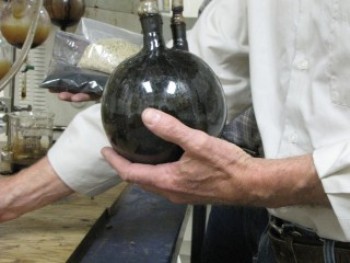It may be feasible for the rural landscapes to sport pyrolysis plants in place of grain fields and oil processing centers to generate bio crude oil from the bio crops such as switchgrass brought in by the farmers.
 South Dakota State University researchers are researching bio-oil and a co-product called biochar. Both are produced along with a product called syngas in a process called pyrolysis. From South Dakota State University News
South Dakota State University researchers are researching bio-oil and a co-product called biochar. Both are produced along with a product called syngas in a process called pyrolysis. From South Dakota State University News
Such crude oil nicknamed as bio-oil will be taken to refineries located elsewhere for processing them into elevated type of fuels and chemicals used in industries. In the refining process, the refineries will seize syngas consisting hydrogen, carbon dioxide or carbon monoxide, a by product of the refining process for their own energy needs. The refining process will also produce an important spin-off known as biochar, which will be used again in the soil to reconstruct the damaged soils, to capture carbon and to change the level of greenhouse gas discharges.
A major study being performed by the researchers of South Dakota State University (SDSU) along with an associate from the U.S. Department of Agriculture, under SDSU professor Tom Schumacher, the project director, is focused in developing a Pyrolysis process to get maximum out of the aforementioned system. The project will receive an annual grant of $200,000 for five years amounting to a total of $1 million to enable the researchers to formulate a feedstock manufacturing structure to manufacture bio-oil that generates optimal energy and further their research on the ecological advantages of using biochar.
The Pyrolysis procedure utilizes increased level of temperatures to break down the organic materials in an environment devoid of oxygen. The research of SDSU will incorporate a procedure known as microwave pyrolysis, which heats up the feedstock by agitating the single molecules in a precise and easy to manage process. The soil scientists and process engineers engaged in the project are working together to study the consequences of varying the pyrolysis treating equations during the biochar and bio-oil production process
The researchers believe that the properties of biochar will largely depend on the chemical and physical properties of the feedstock used and the process procedure followed and it will vary the value of soil improvement. They will study the uniqueness of biochar produced from three types of feedstock such as woody biomass, switchgrass and corn stover.
According to Schumacher, the characteristics and pH of various biochars will have a wide difference due to the usage of feedstock and the process implemented. He explained that the characteristics of biochar will make them valuable, impartial or damaging for use. He further said that the researchers are thrilled about the feasibility of assessing the advantageous benefits of biochar for producing a reliable and qualified product. The researchers also will try to discover the usage of biochar on herbicide assimilation and percolation and how it interacts with them.
The other benefits of biochar include their capability to hold-up and contain carbon for thousands of years, which in turn can assist in slowing down the global warming. Also some of the biochars have the capability to retain phosphorus and preventing them from runoff the field thus enabling the management of nutrients in the field effectively.